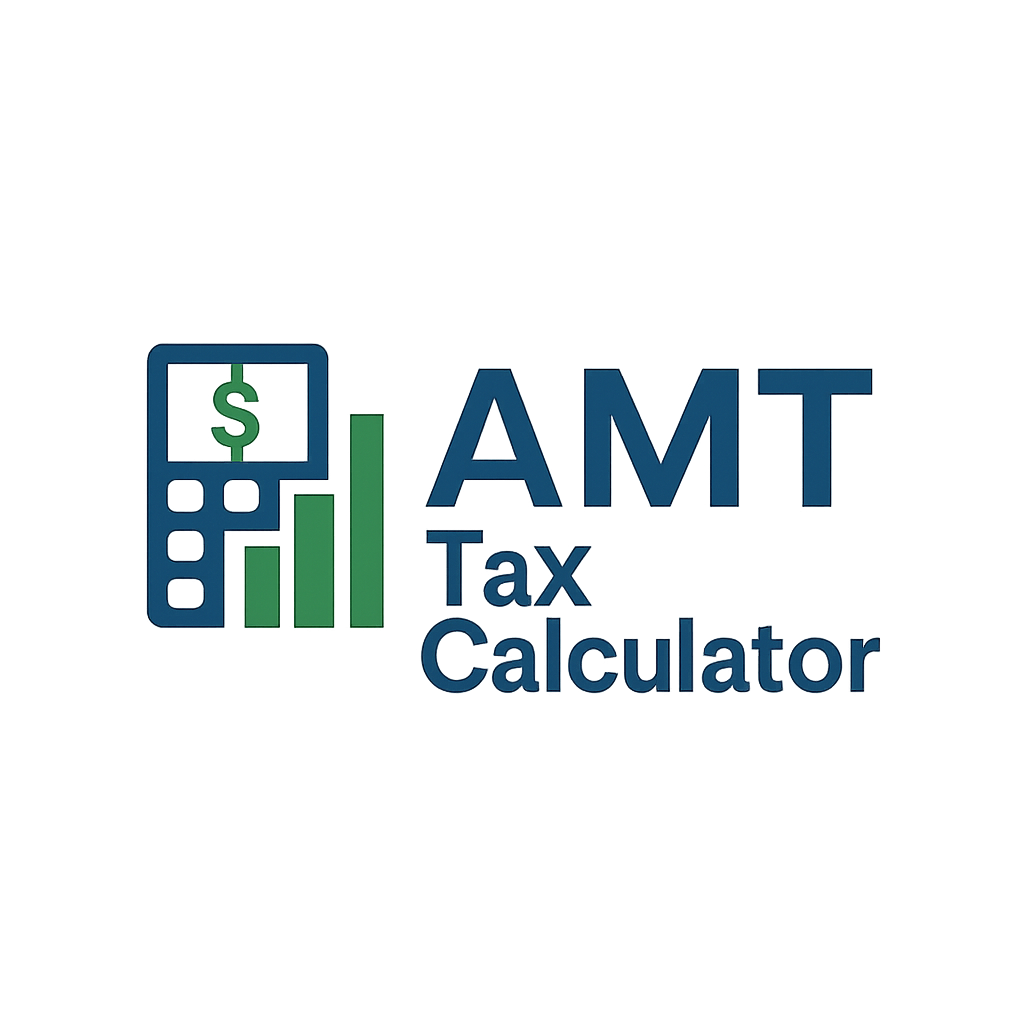AMT Tax Calculator
Alternative Minimum Tax Calculator India
AMT Tax Calculator 2025-26
Calculate Alternative Minimum Tax (AMT) for India FY 2025-26. Compare normal tax liability with AMT at 18.5% and determine your final tax obligation. Includes AMT credit calculation and carry forward provisions.
Income & Tax Details
📊AMT Analysis
📈Final Tax Liability
₹0
Higher of Normal Tax or AMT
Normal Tax
₹0
AMT (18.5%)
₹0
Adjusted Total Income
₹0
AMT Credit
₹0
Calculation Breakdown
AMT Key Points
ℹ️AMT Exemptions
🚫Income Tax Slabs 2025-26
📊New Tax Regime (AY 2026-27)
| Income Slab | Tax Rate |
|---|---|
| Up to ₹4,00,000 | Nil |
| ₹4,00,001 – ₹8,00,000 | 5% |
| ₹8,00,001 – ₹12,00,000 | 10% |
| ₹12,00,001 – ₹16,00,000 | 15% |
| ₹16,00,001 – ₹20,00,000 | 20% |
| ₹20,00,001 – ₹24,00,000 | 25% |
| Above ₹24,00,000 | 30% |
Old Tax Regime
| Income Slab | Tax Rate |
|---|---|
| Up to ₹2,50,000 | Nil |
| ₹2,50,001 – ₹5,00,000 | 5% |
| ₹5,00,001 – ₹10,00,000 | 20% |
| Above ₹10,00,000 | 30% |
*Plus applicable surcharge and 4% Health & Education Cess
Surcharge Rates
| Income Range | Surcharge Rate |
|---|---|
| Up to ₹50,00,000 | Nil |
| ₹50,00,001 – ₹1,00,00,000 | 10% |
| ₹1,00,00,001 – ₹2,00,00,000 | 15% |
| ₹2,00,00,001 – ₹5,00,00,000 | 25% |
| Above ₹5,00,00,000 | 37% |
*Health & Education Cess: 4% on (Income Tax + Surcharge) | AMT Rate: 18.5% on Adjusted Total Income
Free AMT Tax Calculator 2025: Instantly Compute Your Alternative Minimum Tax in India and Plan Smarter
Have you ever wondered if your tax deductions are actually costing you more in the long run? In India’s complex tax landscape, claiming hefty incentives might trigger an unexpected twist: the Alternative Minimum Tax (AMT). This safety net ensures that high-income earners can’t slash their tax bills to zero through clever deductions, but it often catches unsuspecting individuals and businesses off guard.
AMT, or Alternative Minimum Tax, is a parallel tax system designed to guarantee a minimum tax payment, especially for those availing profit-linked benefits. Why does it matter? With rising incomes and more people dipping into deductions like those for SEZs or infrastructure investments, AMT could inflate your tax liability without warning. In this guide, we’ll demystify AMT, show you how to use a free AMT Tax Calculator, and equip you with strategies to minimize its impact—all tailored for Indian taxpayers in 2025.
What is Alternative Minimum Tax (AMT) in India?
Imagine you’re a successful entrepreneur in Mumbai, claiming deductions for your startup’s R&D expenses. Your regular tax bill looks low, but suddenly, AMT kicks in, demanding more. That’s the essence of AMT—it’s India’s way of saying, “Great job on those incentives, but let’s ensure you pay a fair share.”
Introduced in the Finance Act 2011 and effective from Assessment Year (AY) 2012-13, AMT targets non-corporate taxpayers under Section 115JC of the Income Tax Act. Unlike the regular tax regime, it recalculates your income by adding back certain deductions, then applies a flat rate. This prevents “tax avoidance” through excessive claims, much like how Minimum Alternate Tax (MAT) works for companies.
In simple terms, if your normal tax is less than the AMT computed, you pay the higher amount. It’s not an extra tax; it’s an alternative computation to plug loopholes. According to the Income Tax Department, AMT ensures equity in taxation, especially post the liberalization era where incentives boomed.
Who Needs to Pay AMT in India?
Not everyone falls into the AMT net—it’s selective. Picture Raj, a freelance consultant in Bangalore earning Rs 25 lakh annually. He claims Rs 5 lakh in deductions for donations and investments. If his adjusted income crosses the threshold, AMT applies.
AMT is applicable to:
- Individuals, Hindu Undivided Families (HUFs), Associations of Persons (AOPs), Bodies of Individuals (BOIs), and Artificial Juridical Persons.
- Limited Liability Partnerships (LLPs), partnerships, and other non-corporate entities, with recent tweaks in the Income Tax Bill 2025.
Key triggers include claiming deductions under:
- Chapter VI-A (Sections 80H to 80RRB, excluding 80P for cooperatives).
- Section 10AA (for units in Special Economic Zones).
- Section 35AD (for specified businesses like infrastructure or cold chains).
Exemptions? If your adjusted total income is Rs 20 lakh or less (for non-LLPs), you’re safe. For LLPs, there’s no such threshold, but the 2025 Bill clarified exemptions for those with only long-term capital gains (LTCG) without deductions, taxed at 12.5% instead of AMT’s 18.5%.
Statistics from the Central Board of Direct Taxes (CBDT) show that AMT collections have risen 15% year-on-year, reflecting more high-income non-corporates claiming incentives. If you’re a professional in Delhi availing SEZ benefits, check your eligibility pronto.
How Does AMT Work? A Step-by-Step Breakdown
Think of AMT as a backup generator—it only powers up when your main tax “electricity” dips too low. Let’s break it down with a relatable analogy: It’s like ordering a budget meal but being charged for the premium version if you add too many extras.
Step 1: Calculate Your Regular Taxable Income
Start with your gross total income, subtract allowable deductions (except those triggering AMT), and apply slab rates.
Step 2: Compute Adjusted Total Income (ATI)
ATI = Total Income (before AMT-triggering deductions) + Deductions claimed under Chapter VI-A (C), Section 10AA, or Section 35AD – Depreciation (if claimed under 35AD).
For example, if your income is Rs 30 lakh and you claim Rs 8 lakh under Section 10AA, ATI becomes Rs 38 lakh.
Step 3: Apply the AMT Rate
AMT liability = 18.5% of ATI + Surcharge (if applicable) + 4% Health and Education Cess.
Surcharge rates for 2025:
- 10% if ATI > Rs 50 lakh to Rs 1 crore.
- 15% if > Rs 1 crore to Rs 2 crore.
- Up to 37% for higher brackets under the new regime.
Step 4: Compare and Pay the Higher Amount
If AMT > Regular tax, pay AMT. The difference becomes AMT credit, carry-forwardable for up to 15 years.
Recent updates from the Income Tax Bill 2025, passed in August, consolidated AMT and MAT under Clause 206, fixing a drafting error for LLPs. Now, LLPs with pure LTCG (no deductions) avoid AMT, paying only 12.5%—a win for investment firms, as per experts at Dhruva Advisors.
Using Our Free AMT Tax Calculator: A Practical Guide
Tired of manual crunching? Our online AMT Tax Calculator simplifies everything. It’s like having a tax guru in your pocket—input your details, and get instant results.
How to Use the AMT Tax Calculator
- Enter your gross total income for the year.
- Input deductions under relevant sections (e.g., 10AA, 35AD).
- Specify your entity type (individual, LLP, etc.).
- Hit “Calculate”—voila! It shows regular tax, AMT, and any credit.
For instance, let’s say you’re an individual in Chennai with Rs 40 lakh income, claiming Rs 10 lakh under Section 35AD. The calculator might reveal:
- Regular tax: Rs 7.5 lakh.
- ATI: Rs 50 lakh.
- AMT: Rs 9.62 lakh (18.5% + cess).
- Payable: Rs 9.62 lakh, with Rs 2.12 lakh credit.
This tool is updated for FY 2024-25 (AY 2025-26) rules, drawing from official CBDT guidelines. Pro tip: Always cross-verify with a CA, as per TaxGuru recommendations.
Benefits of the Calculator
- Accuracy: Incorporates latest surcharge and cess.
- Speed: Results in seconds, no spreadsheets needed.
- Planning Tool: Simulate scenarios to optimize deductions.
Check our MAT Calculator for Companies if you’re running a business.
Real-World Examples of AMT in Action
Let’s humanize this with stories. Meet Priya, a Hyderabad-based IT consultant. In 2024, her income was Rs 28 lakh, with Rs 6 lakh claimed under Section 80IA for her small infrastructure project. Regular tax: Rs 4.2 lakh. But ATI jumped to Rs 34 lakh, triggering AMT at Rs 6.5 lakh. She paid the higher amount but claimed credit, offsetting it against future taxes when her deductions phased out.
Another case: An LLP in Gujarat with Rs 1 crore LTCG from property sales. Pre-2025 Bill, AMT loomed at 18.5%. Post-revision, they’re exempt, saving Rs 6 lakh, as highlighted in Business Standard reports.
These examples show AMT’s bite but also its fairness—ensuring the wealthy contribute amid India’s 7% GDP growth.
Key Differences Between AMT and MAT
Confused between AMT and MAT? You’re not alone. MAT is for companies (Section 115JB), based on book profits at 15% (or 18.5% for some). AMT is for non-corporates, on adjusted income at 18.5%.
| Aspect | AMT | MAT |
|---|---|---|
| Applicability | Non-corporates (individuals, LLPs) | Companies |
| Base | Adjusted Total Income | Book Profits |
| Rate | 18.5% | 15-18.5% |
| Threshold | Rs 20 lakh ATI (non-LLPs) | None |
| Credit Carry Forward | 15 years | 15 years |
Source: ClearTax and TaxGuru analyses.
For official details, visit Income Tax India.
Tips to Minimize AMT Liability in 2025
AMT isn’t inevitable—smart planning helps. Here are actionable insights:
- Spread Deductions: Don’t bunch claims in one year; phase them to keep ATI below thresholds.
- Opt for New Regime: If deductions are low, switch to the simplified regime without Chapter VI-A benefits, dodging AMT.
- Claim Credit Wisely: Use AMT credit when regular tax exceeds AMT in future years.
- For LLPs: Focus on LTCG without deductions, leveraging 2025 exemptions.
- Consult Experts: A CA can model scenarios; as per Cyril Amarchand Mangaldas blog, this avoids “unintended consequences.”
Humor alert: AMT is like that friend who insists on splitting the bill evenly—fair, but sometimes annoying!
Common Mistakes to Avoid When Calculating AMT
I’ve seen folks trip up here. One client forgot to add back Section 35AD depreciation, understating ATI by Rs 2 lakh. Another ignored surcharge, inflating their refund expectations.
- Mistake 1: Ignoring thresholds—always check if ATI > Rs 20 lakh.
- Mistake 2: Not filing Form 29C (certificate for AMT computation).
- Mistake 3: Forgetting credit carry-forward, losing potential savings.
Rhetorical question: Why risk penalties when a quick calculator run can save headaches?
Impact of Recent Tax Reforms on AMT
The Income Tax Bill 2025, passed in Lok Sabha on August 11, 2025, brought clarity. It reinstated AMT exemptions for LLPs with sole LTCG, correcting a drafting error that could’ve hiked taxes to 18.5%. As per Economic Times, this relieves investment LLPs amid India’s booming economy.
For individuals, no major rate changes—18.5% holds. But with GDP growth prompting more incentives, AMT scrutiny rises. Expert opinion from Dinesh Kanabar (Dhruva Advisors): “This aligns with simplifying tax without policy shifts.”
Explore Tax Saving Tips for 2025.
AMT Credit: How to Claim and Utilize It
Paid extra due to AMT? Don’t fret—claim credit! It’s the difference between AMT and regular tax, usable when regular tax > AMT in subsequent years.
Example: In Year 1, AMT Rs 10 lakh, regular Rs 8 lakh—credit Rs 2 lakh. Year 2: Regular Rs 12 lakh, AMT Rs 9 lakh—pay Rs 10 lakh (12 – 2 credit).
Carry forward up to 15 years; no interest, but invaluable for fluctuating incomes.
Why Use an Online AMT Calculator Over Manual Methods?
Manual calc is like navigating Mumbai traffic without GPS—possible, but error-prone. Online tools factor in dynamic rates, surcharges, and updates automatically.
Our calculator is mobile-friendly, secure, and free—perfect for busy professionals. Plus, it generates reports for your records.
CTA: Try it now and share your savings story in the comments!
Conclusion
Navigating Alternative Minimum Tax doesn’t have to be daunting. We’ve covered its basics, applicability, calculation, and tips to outsmart it, all while highlighting our free AMT Tax Calculator as your go-to tool for 2025. Remember, AMT ensures fairness but rewards proactive planning—use credits, optimize deductions, and stay updated with reforms like the 2025 Bill.
Key takeaways:
- AMT applies at 18.5% on adjusted income if it trumps regular tax.
- Exempt for low-income non-LLPs; LLPs get LTCG relief.
- Use our calculator for instant, accurate estimates.
What if AMT surprises you this filing season? Don’t let it—grab our tool, consult a pro, and tax smarter. Ready to calculate? Head to the tool and let us know your thoughts below!
FAQs on Alternative Minimum Tax (AMT) in India
What is the current AMT rate in India for 2025?
The AMT rate remains 18.5% plus applicable surcharge and 4% cess, unchanged from previous years per the Income Tax Bill 2025
Who is exempt from paying AMT?
Individuals/HUFs/AOPs with adjusted total income ≤ Rs 20 lakh are exempt. LLPs with only LTCG (no deductions) also qualify post-2025 reforms
How do I calculate AMT credit?
It’s the excess of AMT over regular tax, carry-forwardable for 15 years to offset future liabilities when regular tax exceeds AMT.
Does AMT apply to salaried employees?
Yes, if they claim triggering deductions like Section 80IA and ATI > Rs 20 lakh—common for high earners with investments
What’s the difference between AMT and regular income tax?
AMT is an alternative computation adding back certain deductions; you pay the higher of the two to prevent excessive tax savings
Can I use AMT credit against any tax?
Only against future income tax when regular liability > AMT; not for penalties or interest.
Is there an official AMT calculator from the government?
No, but tools like ours align with CBDT guidelines. Always verify with Form 29C certification.





